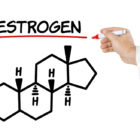Mention the word ovaries and most people think reproduction. But the ovaries are much more than two tip-of-your-thumb-sized oval egg containers. Of course reproduction is one of their primary functions. But the ovaries are also highly specialized endocrine glands – organs that produce hormones affecting nearly every organ in a woman’s body throughout her lifetime. As in puberty, perimenopause is a time when hormones are fluctuating wildly and that creates some confusion. Estrogen levels may drop by as much as 90% from their normal reproductive highs by the time of menopause and that causes FSH levels to rise; but early in perimenopause, estrogen levels may actually be elevated. Low estrogen levels can cause hot flashes and other symptoms.
Testosterone and androstenedione are two androgen hormones that also change during and after menopause. They are called androgens or “male hormones.” Even though they are found in both men and women, women have lower levels of them than men just like men have lower estrogen levels than women. After menopause, testosterone levels drop by as much as 28%. It happens in all women but it happens faster and to a greater extent in women who have had their ovaries removed. Before menopause, about 25% of testosterone is made in the ovaries; another 25% comes from the adrenal glands and the remaining half come the body’s fat cells.
After menopause the percentages change. One fourth is still produced in the adrenal glands, but the ovaries now produce 40% and the fat cells make 35%. That is one real benefit from keeping one’s ovaries in – it keeps testosterone levels higher and helps lessen the symptoms of perimenopause and menopause. As Dr. Susan Love’s Hormone Book puts it, “The menopausal ovary is neither failing nor useless. It’s simply beginning to shift from its reproductive to its maintenance function. It’s doing in midlife exactly what many people do – it’s changing careers.”
After menopause, the adrenal glands slowly begin to produce lesser amounts of another hormone – androstenedione. Because the drop in testosterone and androstenedione happens slowly, postmenopausal women who experience natural menopause usually don’t have a loss of libido. If there is a loss of libido and testosterone levels aren’t low, giving testosterone probably won’t make it better. Other causes of a loss of libido must be looked for. But if testosterone levels are lower than expected, testosterone replacement can and often does make a difference.
Bonus: Factors Affecting Age of Menopause
Until next time,
Dr. Mache Seibel, Founder of My Menopause Magazine http://bit.ly/MyMenoMag
Professor, University of Massachusetts Medical School
(617) 916-1880
PS: Find more information of this type in My Menopause Magazine, available for the iPad in the Apple Newsstand. http://bit.ly/MyMenoMag
* Please Like and share with your friends.





